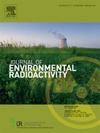Physics-informed optimization for emergency radiation assessment with temporal correction under meteorological uncertainty
IF 2.1
3区 环境科学与生态学
Q3 ENVIRONMENTAL SCIENCES
引用次数: 0
Abstract
Timely and accurate radiation dose assessment is essential for effective emergency response in nuclear accidents. However, meteorological uncertainties, especially in wind data, can lead to substantial discrepancies between simulated and observed plume behaviors, compromising situational awareness and decision-making. This study proposed a physics-informed optimization framework that integrates a physical radiation assessment model with a genetic algorithm to dynamically correct time-series wind field data and mitigate discrepancies caused by meteorological uncertainty. The physical model couples the Lagrangian puff model with the point kernel integration method. To improve efficiency, a dimensionality reduction approach simplifies the three-dimensional gamma dose integration to one dimension. The proposed framework was validated using the first venting scenario of Unit 1 at the Fukushima Daiichi Nuclear Power Plant. The temporal optimization significantly enhanced the alignment of estimated and observed plume passage times. Quantitatively, the optimization respectively reduces the fractional bias (FB) and the normalized mean square error (NMSE) at the Main Gate by 57.82 % and 90.69 %, while the improvements at MP8 station reached 97.88 % (FB) and 92.19 % (NMSE). The FAC2 (Fraction of predictions within a factor of two) at the Main Gate increased substantially from 9.5 % to 52.4 % post-optimization. These improvements demonstrate the effectiveness of the proposed method in enhancing predictive accuracy for emergency radiation dose assessment and optimizing operational decision-making under complex atmospheric conditions.
气象不确定性下具有时间校正的应急辐射评估的物理信息优化
及时、准确的辐射剂量评估是有效应对核事故应急的必要条件。然而,气象的不确定性,特别是在风数据中,可能导致模拟和观测羽流行为之间的巨大差异,从而影响态势感知和决策。本研究提出了一个基于物理的优化框架,该框架将物理辐射评估模型与遗传算法相结合,以动态校正时间序列风场数据,并减轻气象不确定性造成的差异。物理模型将拉格朗日泡芙模型与点核积分法相结合。为了提高效率,采用降维方法将三维伽马剂量积分简化为一维。采用福岛第一核电站1号机组的第一次排气情景验证了提议的框架。时间优化显著提高了估算和观测到的羽流通过时间的一致性。定量分析表明,优化后正门站的分数偏差(FB)和归一化均方误差(NMSE)分别降低了57.82%和90.69%,MP8站的分数偏差和归一化均方误差(NMSE)分别降低了97.88%和92.19%。优化后,正门的FAC2(因子2内的预测分数)从9.5%大幅增加到52.4%。这些改进证明了该方法在提高复杂大气条件下应急辐射剂量评估的预测精度和优化操作决策方面的有效性。
本文章由计算机程序翻译,如有差异,请以英文原文为准。
求助全文
约1分钟内获得全文
求助全文
来源期刊

Journal of environmental radioactivity
环境科学-环境科学
CiteScore
4.70
自引率
13.00%
发文量
209
审稿时长
73 days
期刊介绍:
The Journal of Environmental Radioactivity provides a coherent international forum for publication of original research or review papers on any aspect of the occurrence of radioactivity in natural systems.
Relevant subject areas range from applications of environmental radionuclides as mechanistic or timescale tracers of natural processes to assessments of the radioecological or radiological effects of ambient radioactivity. Papers deal with naturally occurring nuclides or with those created and released by man through nuclear weapons manufacture and testing, energy production, fuel-cycle technology, etc. Reports on radioactivity in the oceans, sediments, rivers, lakes, groundwaters, soils, atmosphere and all divisions of the biosphere are welcomed, but these should not simply be of a monitoring nature unless the data are particularly innovative.
 求助内容:
求助内容: 应助结果提醒方式:
应助结果提醒方式:


